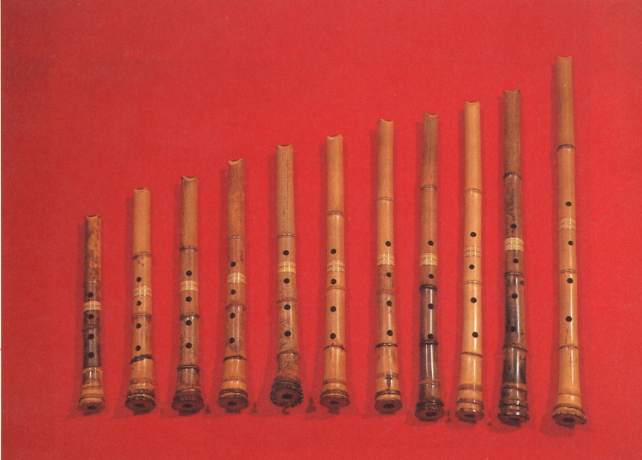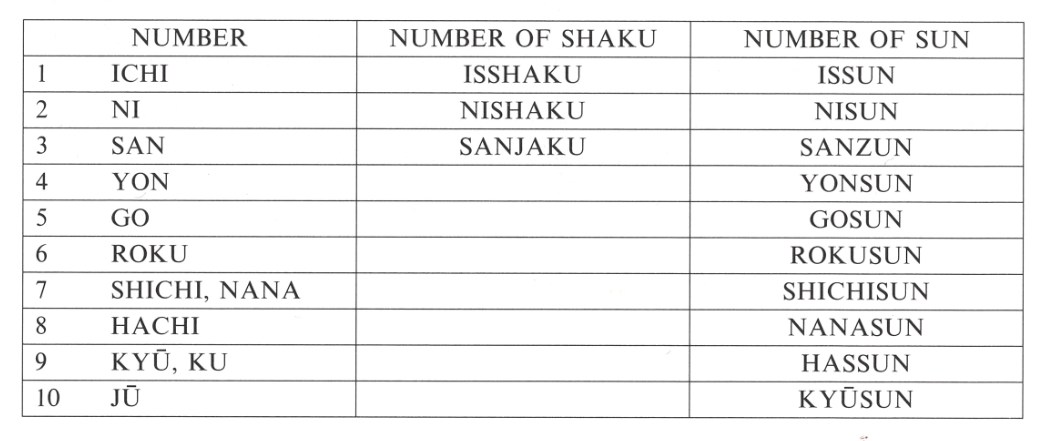quotation:The Encyclopedia of Musical Instruments the SHAKUHACHI
Tokyo Ongaku-sha Co.Ltd 1990
引用:楽器の事典 尺八
(株)東京音楽社 1990年発行
CHAPTER2 : CLASSIFICATIN ACCORDING
TO LENGTH OF INSTRUMENT
The word "shakuhachi" refers to the length of the instrument, "one shaku and eight sun”[isshaku hassun], which is about 54 centimeters. This is the standard length. The proper name is isshaku hassun kan, but this is abbreviated as hassun and as hassun kan, omitting isshaku. In its narrow sense, shakuhachi refers only to those instruments with a length of isshaku hassun, but it also used to refer broadly to instruments both longer and shorter than this length. And this wider meaning also includes all the shakuhachi of ancient and medieval times.
(Photograph 2) shows the shakuhachi of various lengths. The standard instrument is the fifth from the left. As the body of the instrument becomes shorter, the finger holes become closer together. For people with large fingers, it may be difficult to handle instruments that are shorter about isshakusanzun (photograph 2, left). Please see Graph 1. As the body of the instrument becomes longer, the distance between finger holes becomes greater, so it becomes difficult to reach the finger holes in the case of instruments longer thannisshaku sanzun (photograph 2, right).
In terms of demand for the various shakuhachi, the standard length shakuhachi of isshaku hαssun constitutes about 50%.The shakuhachi with a length of isshaku rokusun constitutes about 25% of demand. The remaining 25%is divided among shakuhachi of various lengths, but that which has a length of nisshaku issun has a comparatively large share.
A difference in length of 1 sun produces a difference in pitch of half a tone. The shakuhachi that is 1 sun longer than standard will have a pitch that is half a tone lower, that which is 1 sun shorter will have a pitch that is half a tone higher. However, when we actually measure this difference, we find that as the instrument becomes longer the difference becomes greater than half a tone, so in fact 1 sun difference is not limited to a difference of half a tone. There is a difference of one octave between the isshaku issun shakuhachi and the nishaku sanzun shakuhachi, and between the nishaku sanzun shakuhachi and the nishaku gosun shakuhachi. This is because the relation of one to two does not hold true when actually measured.
The basic key of the shakuhachi is produced by closing all the finger holes at once and is termed tsutsune (see glossry).In the case of the standard length shakuhachi, tsutsune is the key of D. Of the shorter instruments, the issahku rokusun instrument is in the key of E, and the isshaku sanzun is in the key of G. Of the longer shakuhachi, the nisshaku instrument is in the key of B,and that of nisahku sanzun is in the key of A. When the shakuhachi is used in ensemble playing, the score will indicate which shakuhachi is to be used. However, there are cases when the length of the instrument is not specified and the same piece of music is played on both the standard length instrument and those that are longer and shorter.
(Photograph 2)
(photograph 2, left)
(photograph 2, right)

TABLE 1
NAMES OF SHAKUHACHI CLASSIFIED ACCORDING TO LENGTH
NOTE : Terms such as isshaku hassun are used in two ways. First, it refers to the length of
1 shaku and 8 sun. Secondly, it is used as the name of a shakuhachi of that length. In this
book, when isshaku hassun is used as a length it is written as 1 shaku and 8 sun and when
it is used as a name it is written in italic type. The graph below how numeric terms are
combined with the measures of shaku and sun※(see glossry).

(glossary)
※TSUTSUNE refers to the pitch when all the holes are closed. In the case of the standard shakuhachi it is the pitch d1,but when the technique of meri is used its range is lowered by the major second and one can play as low as c1.
※SHAKU and SUN are units of length used in japan in the past. There is some variation in its length depending on historical period, geoeraphical aera, and application, but from the beginning of the twentieth century the length of one shaku was fixed at 30.3 centimeters. Since one foot is approximately 30.48 centimeters, the shaku is almost epuivalment to the foot. The sun is 1/10th of a shaku in other words 3.03centimeters. A tenth of a sun is referred to as bu. An inch is 1/12th of a foot, approximately 2.54 centimeters, so an inch is slighly shorter than a sun. In 1962, the use of shaku and sun become forbidden by law, but in traditional crafts and industries, the old stendsed of measurement are still the foundation. In China, too, the shaku was formerly used, but ther, as in Japan as well, there was variation according to period and locality .
The Encyclopedia of Musical Instruments CONTENTS
⇐previous page the next page⇒


